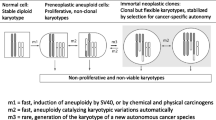Abstract
When thymidine kinase-deficient mouse cells “transformed” by inactivated herpes simplex virus and expressing the viral thymidine kinase (TK) are grown in nonselective medium, there is an exponential decay in the proportion of cells that continue to express the viral enzyme. However, the viral TK can be reactivated at a frequency of approximately 1 cell in 10 6 in every population that has lost TK activity. When cells in which the viral TK has been reactivated are grown in nonselective medium, a decay in the expression of the viral enzyme occurs again at the same rate as in the initial transformed population. Studies on the reactivation of viral TK indicate that reappearance of the enzyme is not induced by the selective medium (HAT) used to detect cells in which the enzyme has reappeared. Furthermore, treatments known to induce latent viruses in other systems—eg, exposure of the cells to mutagens or cell fusion—do not affect the frequency with which viral TK is reactivated.
Similar content being viewed by others
Literature cited
Dubbs, R., and Kit, S. (1964).Virology 22:493–502.
Aron, G. M., Schaffer, P. A., Courtney, R. J., Benyesh-Melnick, M., and Kit, S. (1973).Intervirology 1:96–109.
Munyon, W., Kraiselburd, E., Davis, D., and Mann, J. (1971).J. Virol. 7:813–820.
Davidson, R. L., Adelstein, S. J., and Oxman, M. N. (1973).Proc. Natl. Acad. Sci. USA 70:1912–1916.
Littlefield, J. (1964).Science 145:709.
Lowy, D. R., Rowe, W. P., Teich, N., and Hartley, J. W. (1971).Science 174:155–156.
Aaronson, S. A., Todaro, G. J., and Skolnick, E. M. (1971).Science 174:157–159.
Weiss, R. A., Friis, R. R., Katz, E., and Vogt, P. K. (1971).Virology 46:920–938.
Koprowski, H., and Knowles, B. (1974). InSomatic Cell Hybridization, (ed.) Davidson, R. L., and de la Cruz, F. (Raven Press, New York) pp. 71–99.
Neff, J. M., and Enders, J. F. (1968).Proc. Soc. Exp. Biol. Med. 127:260–267.
Luria, S. E., and Delbruck, M. (1943).Genetics 28:491–511.
Teich, N., Lowy, D. R. Hartley, J. W., and Rowe, W. P. (1973).Virology,51:163–173.
Author information
Authors and Affiliations
Rights and permissions
About this article
Cite this article
Kaufman, E.R., Davidson, R.L. Control of the expression of a herpes simplex virus thymidine kinase gene incorporated into thymidine kinase-deficient mouse cells. Somat Cell Mol Genet 1, 153–163 (1975). https://doi.org/10.1007/BF01538545
Received:
Revised:
Issue Date:
DOI: https://doi.org/10.1007/BF01538545




